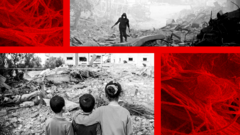The ongoing conflict in Gaza has not only resulted in substantial loss of life but has also unleashed a hidden peril: asbestos exposure. This toxic mineral, once a staple in construction materials, poses severe health risks as it releases microscopic fibers into the air. These fibers can infiltrate the lungs and lead to severe illnesses, including cancer, decades after exposure. Despite its ban in many nations, asbestos remains a significant concern in Gaza, particularly in its older refugee camps established during the 1948-49 Arab-Israeli war, as outlined by the United Nations Environment Programme (UNEP).
A recent UNEP assessment estimated that up to 2.3 million tons of rubble might be contaminated with asbestos, exacerbating the risks for the local population. Professor Bill Cookson, a leading authority on mesothelioma, warns that the rubble presents "a very, very toxic environment." The symptoms of asbestos-induced illnesses are often delayed, leading to potential health crises emerging in the years to come. Liz Darlison, CEO of Mesothelioma UK, emphasized, "The lives lost now are not going to end here," indicating the long-term ramifications of asbestos exposure.
The inhalation of asbestos fibers leads to severe lung diseases, such as asbestosis and mesothelioma, which usually manifests 20 to 60 years post-exposure. Dr. Ryan Hoy noted the challenge of avoiding such exposure in Gaza’s densely populated environment, where fear of immediate threats overshadow concerns about long-term health risks. He stated that the tiny particles of asbestos are pervasive in the air, making them impossible to avoid.
Local health officials report that residents are currently focusing on surviving the conflict, leaving them ill-equipped to manage the risks associated with asbestos. Many lack awareness about the dangers posed by the dust and debris surrounding them, as they struggle to meet their basic needs amidst ongoing violence. This situation echoes concerns from previous conflicts in the region, with similar toxic threats having been identified after earlier hostilities.
A crucial aspect of addressing the aftermath of the destruction in Gaza lies in managing the debris removal process. UN officials cautioned that careless handling of asbestos-contaminated rubble could release hazardous fibers into the air, further endangering the population. The recovery efforts are expected to take 21 years and could cost up to $1.2 billion, potentially creating a larger public health challenge.
As the discourse around reconstruction strategies intensifies, both local and international authorities must navigate the dual crisis of immediate violence and long-term health implications. Health experts warn that the fallout from asbestos exposure could eclipse current threats, calling for urgent awareness and action to tackle this silent killer in Gaza's rubble-strewn landscape.
A recent UNEP assessment estimated that up to 2.3 million tons of rubble might be contaminated with asbestos, exacerbating the risks for the local population. Professor Bill Cookson, a leading authority on mesothelioma, warns that the rubble presents "a very, very toxic environment." The symptoms of asbestos-induced illnesses are often delayed, leading to potential health crises emerging in the years to come. Liz Darlison, CEO of Mesothelioma UK, emphasized, "The lives lost now are not going to end here," indicating the long-term ramifications of asbestos exposure.
The inhalation of asbestos fibers leads to severe lung diseases, such as asbestosis and mesothelioma, which usually manifests 20 to 60 years post-exposure. Dr. Ryan Hoy noted the challenge of avoiding such exposure in Gaza’s densely populated environment, where fear of immediate threats overshadow concerns about long-term health risks. He stated that the tiny particles of asbestos are pervasive in the air, making them impossible to avoid.
Local health officials report that residents are currently focusing on surviving the conflict, leaving them ill-equipped to manage the risks associated with asbestos. Many lack awareness about the dangers posed by the dust and debris surrounding them, as they struggle to meet their basic needs amidst ongoing violence. This situation echoes concerns from previous conflicts in the region, with similar toxic threats having been identified after earlier hostilities.
A crucial aspect of addressing the aftermath of the destruction in Gaza lies in managing the debris removal process. UN officials cautioned that careless handling of asbestos-contaminated rubble could release hazardous fibers into the air, further endangering the population. The recovery efforts are expected to take 21 years and could cost up to $1.2 billion, potentially creating a larger public health challenge.
As the discourse around reconstruction strategies intensifies, both local and international authorities must navigate the dual crisis of immediate violence and long-term health implications. Health experts warn that the fallout from asbestos exposure could eclipse current threats, calling for urgent awareness and action to tackle this silent killer in Gaza's rubble-strewn landscape.



















